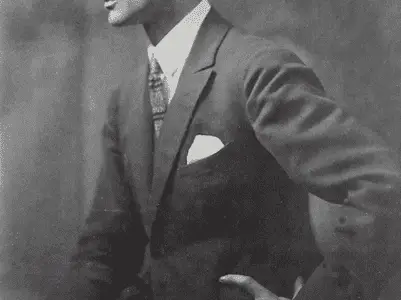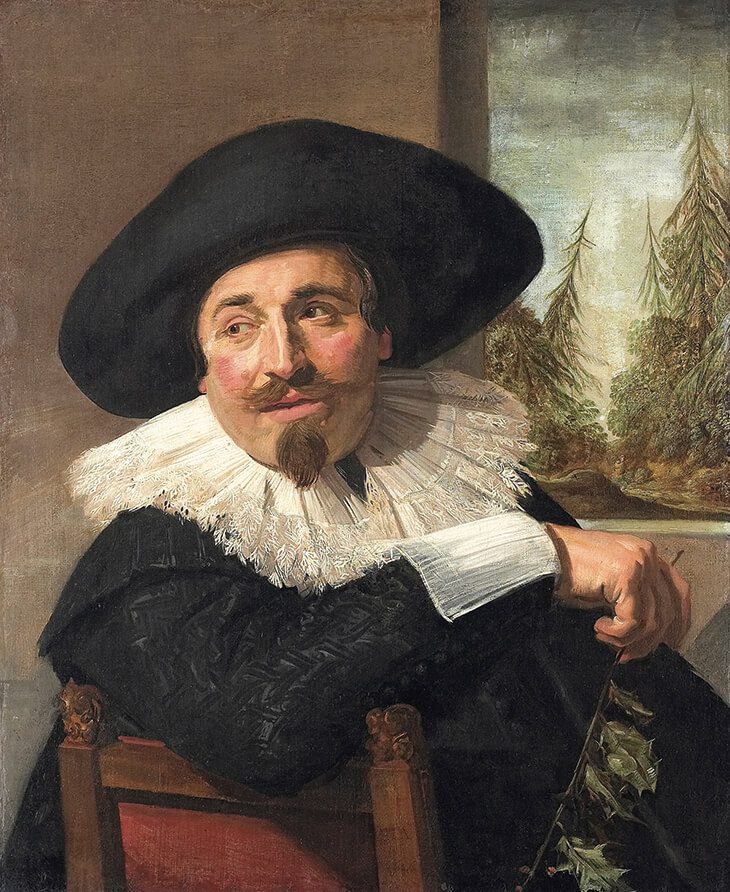The Unseen Aesthetics: Influences on Frederic Edwin Church’s Art

The legacy of Frederic Edwin Church, one of the most remarkable figures of the Hudson River School, constitutes a rich tapestry of inspirations and influences, both personal and from the wider cultural milieu of his time. Church’s paintings were greatly informed by his apprenticeship with Thomas Cole, one of the pioneers of the Hudson River School. His works effortlessly melded Cole’s romantic, atmospheric landscapes with his own meticulous observations from his travels, particularly his impressions of South America and the Middle East. Church’s passion for exploring the world made its mark on his art, as he enthusiastically captured the diversity of local flora, fauna, and geography in his detailed, sweeping landscapes. Moreover, he lived in an era swirling with scientific discoveries, which provided a unique lens through which to perceive and capture the natural world in his works. Beyond the surface layer of naturalistic detail, however, his paintings are also imbued with a profound spiritual significance, representing his deeply held belief in nature as a manifestation of divine creation.
Influence of Thomas Cole
Thomas Cole’s Impress on Frederic Edwin Church: A Study of Artistic Influence
A captivating journey through the realms of nature, beauty, and the magnificent world of art, inextricably twines the life, work, and teachings of Thomas Cole and Frederic Edwin Church. As a torchbearer of the Hudson River School, Cole’s impactful contributions constituted an invaluable wellspring for the technical prowess and artistic genius of Frederic Edwin Church.
Undeniably, it was under the leafy canopy of Cole’s mentorship where Church’s artistic perspective truly began to flourish. Embarking upon these verdant trails of untapped creativity, Church absorbed the seminal lessons on landscape painting that Cole – a master in his own right – had to offer.
Imbibing the rich essence of Cole’s teachings on the transcendentalism of nature, Church deftly draped the canvas of his creativity with panoramic depictions of the natural world. This was a dance of colour and form that Cole himself was no stranger to and one which he passed down passionately. It was this love for pristine beauty, the unhindered wilderness, and a sense of the Sublime that Church would later implement into his own masterpieces.
Yet, the impact of Cole on Church was not limited to the realm of technique or subject matter alone. Cole also nurtured Church’s understanding of the canvas as a space for moral and cultural reflections. Church absorbed this appreciation, using his own art to highlight important issues of his day such as environmental conservation and cultural understanding. This was a testament to the depth of Cole’s teachings, resolved not merely in mastering the brush but embracing the voice it provided.
Furthermore, Church’s employment of luminism—using light and nuanced shading to create a sense of awakening on canvas—echoes Cole’s emphasis on using art to capture the awe-inspiring power of creation. This incorporation is a clear example of Cole’s resounding influence, shaping and moulding the artistic perspective of his student.
In the world of Church’s artistry, the works and teachings of Thomas Cole exist as an undeniable footprint. This influence shaped Church’s artistic perspective, leading him down his own path of greatness. Through his vivid renditions of nature’s beauty, Church paid the most resounding tribute to his mentor, embodying the essence of Thomas Cole’s majestic perspective in each masterful stroke.
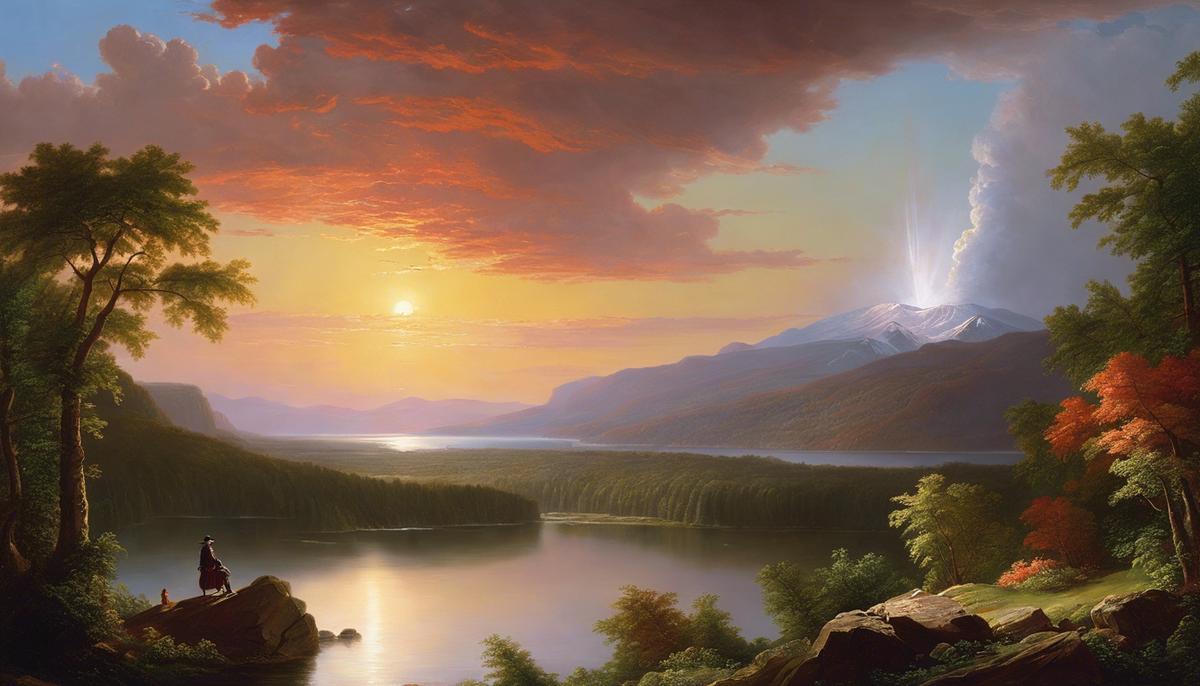
Church’s Travelling Experiences
The Etchings of Adventure & Nature: The Markings of Travel on Frederic Edwin Church’s Artistry
Venturing beyond the luscious havens of upstate New York where his foundations as an artist were formed under the guidance of Thomas Cole, to the tropic jungles, the looming mountains, and vast tundras, Frederic Edwin Church embarked upon multiple trips that indelibly imprinted his art. The geographical diversity captured in the journeys he undertook was transmuted into exquisite renderings of nature on his canvas.
Church’s journeys led him to unfamiliar lands and exposed him to an array of stunning yet contrasting scenes. These experiences undeniably reshaped and deepened the nature of his artistic output. The influences of these travels can be traced throughout his later body of work, adding a new layer to his technical mastery and the philosophical underpinnings of the sublime and transcendentalism inherited from his mentor Cole.
One of his most noteworthy excursions began in 1853, where his journey took him through South America. This expedition was not only geographical but historical as well – inspired by Alexander Von Humboldt’s “Cosmos”. His encounters with the exotic landscapes birthed magnificent paintings such as “Cotopaxi” and “The Andes of Ecuador”. Church’s introduction to this unfamiliar terrain was cataclysmic and offered stunning terrain for his hallmark feature of luminism to unfurl.
This mastery was further demonstrated throughout his 1857 trip to Newfoundland and Labrador where he bore witness to a stark contrast in terms of environment and climate – a shift from the tropics to the wintry expanse. This journey resulted in a new collection of artworks such as “Icebergs and Wreck in Sunset”. Here Church’s luminism was challenged to adapt to a colder and sterner environment, casting a different light.
The spark ignited through travel evolved further as he transcended geographical boundaries, voyaging to the Ottoman Empire, Europe, and the Middle East, hence collecting a plethora of landmarks, culture, and history along the way. An exceptional creation from this period, “Jerusalem from the Mount of Olives”, emphasises an evolution in his panoramic landscape approach and perspectival composition.
Every travelled path brought with it a veritable cornucopia of scenes, people, experiences, architectures, and geographies – each significant and each divergent. They ingrained in him a heightened sense of observation and a lavish palette of colours, forms, and light. As a result, his later works became famed for their meticulous detail, rich colour, and vast scope, capturing the essence of his global journeys.
In essence, Church’s treks etched a rich tapestry of varied influences and inspirations into his practice that were reflected through his spectacular renderings of the natural world. His artworks became visual diaries, a vivid recollection of his travels, the splendour and diversity of the world immortalised in oil and canvas. His art was no longer confined to the teachings of Cole but a testament to a global perspective, shaped by his immersive travelling experiences.
The journey of this artist, from the guidance of his revered mentor Thomas Cole to the exotic locales he traversed, is mirrored in the transformation of his art, a testament to the true spirit of creativity and the sublime nature of exploration. Each stroke of his brush was a testament of his journey, a manifestation of his travels, and a tribute to the vastness of his lived experiences.
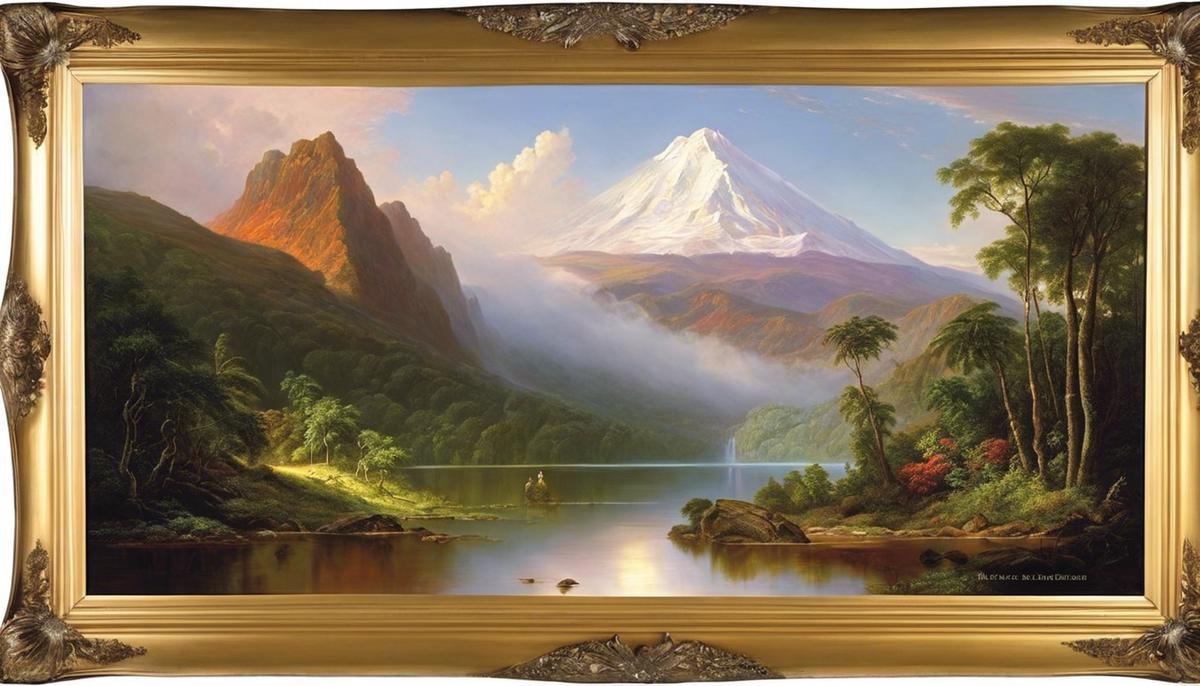
The Influence of the Hudson River School
Diving deeper into the colourful tapestry of Frederic Church’s creative journey, it becomes clear how intimately tied his style was to the philosophies of the Hudson River School. It was not only a movement but a hive of great ideals and grand imaginings that gathered the sparks of inspiration from both the natural world and man’s relationship with it.
A key characteristic of the Hudson River School was the adoration and reverence towards nature. This perspective is embroidered throughout Church’s works. One cannot ignore the dazzling play of light and darkness, an echoing quality of the school’s love for luminism. Yet Church used this technique not just for aesthetic appeal, but to add a depth of narrative to his scenes. With each shifting beam of sunlight or ominous, brooding cloud, Church communicated a distinct mood, a story unfolding both on and beneath the canvas.
But what set Church apart from many of his contemporaries was his global perspective. Emboldened by the teachings of the Hudson River School and an insatiable thirst for discovery, Church embarked on extensive travels that broadened his horizons immeasurably. This exposure to diverse landscapes became a building block in his artistic style.
Where the Hudson River School often focused on the majestic landscapes of North America, Church’s travels allowed him to capture the essence of lands far removed, from the exotic allure of South America to the time-etched grandeur of the Middle East. Yet, in each piece, he remained true to the philosophy that the natural world was something to be respected, cherished, and protected. This homage to the natural world, delight in its diversity, and urge to protect its splendour is a testament to the ideals of the Hudson River School.
Furthermore, the School’s emphasis on detailed observation found its full expression in Church’s work. He didn’t just aim to recreate a scene; he strived to transport the observer, immerse them within the landscape. He packed his works with minutiae that on the surface may seem trivial, yet they breathed the spirit of the places he visited and reflected the essence of its spirit.
In essence, Frederic Church’s artistic style was not just inspired by the Hudson River School, it was shaped and honed by it. It is in the vast landscapes, the vivid explosions of colour, and the reverence for nature’s grand design that Church truly paid homage to this school of thought. His style continues to serve as a testament to the lasting influence that this artistic movement had, and it affirms its role as the cradle of American landscape painting. Through visually breathtaking, emotion-stirring, and thought-provoking art, Church encapsulated its ideology and spirit into timeless masterpieces. Infused with creativity, exploration and an unwavering love for the natural world, Church’s journey captured the very essence of the heart that beat within the Hudson River School.
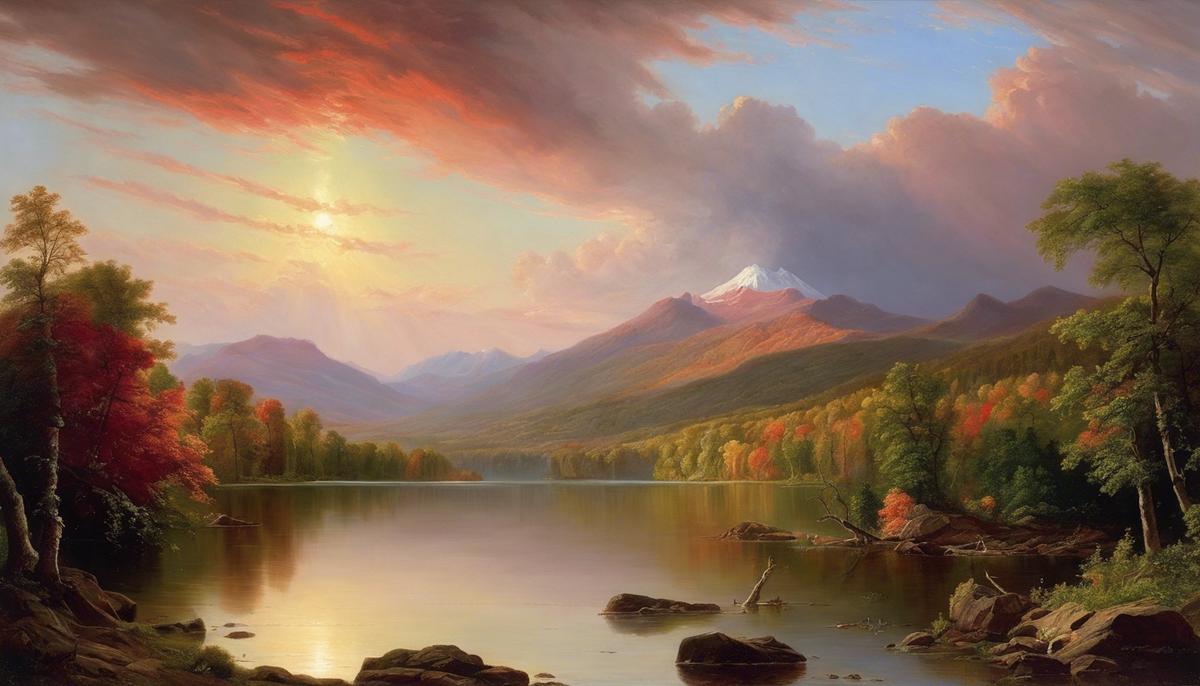
Church’s perception of Nature and Religion
Delving deeper into Church’s legacy, it’s fascinating to see how his perception of nature and religion played a significant role in shaping his artistic narrative. His visionary approach and philosophical perspective towards existential concepts were clearly mirrored in his artistic works, signifying the interrelationship between his life truths and artistic expression.
Church’s perception of nature went beyond its visual allure; he saw it as a manifestation of divine creation. This need to represent what he considered sublime in nature drove his luminous and detail-rich portraiture of landscapes. His masterpieces reflect his perception of a sacred bond between Man and Nature, alluding to common biblical themes by portraying nature as a peaceful sanctum offering solace and spiritual renewal.
Rooted deeply in the Hudson River School tradition, Church faithfully followed the tenet of painting nature ‘as it is’ in all its majesty. His strong spiritual beliefs coupled with a profound appreciation for untamed nature, triggered a synergy that contributed to his spellbinding portrayal of landscapes. His sublime presentations are often viewed as visual interpretations of biblical Psalms, further connecting his work with his faith.
Religion for Church wasn’t confined to the practice of spirituality but was an all-encompassing worldview that influenced how he perceived and interacted with his surroundings. This view is echoed in his awe-inspiring landscape sagas where each detail, each contour, each hue, appears hallowed and profound, hinting at a divine, god-like entity as the originator.
The magnitude of nature’s dimensions captured in his panoramic landscapes becomes a metaphor for not just physical, but also spiritual exploration. The grand scale of his paintings is often seen as Church’s earnest endeavour to envelop viewers in his immersive vision of the vastness of God’s creative genius. His portrayals may not directly attribute to religious contexts, but the allusion to the Divine is evident in the way he captures the almost ‘otherworldly’ beauty of nature.
Through his artistic journey, Church repeatedly broke the traditional confines of landscape painting by infusing it with a uniquely devotional and mystical essence. His vivid and exuberant canvases stand as testaments to his passion for nature and his affinity towards spiritual upliftment. Religion and nature thus, in Church’s philosophy, seamlessly merge into one, reflecting the divine fusion of existential realms in his artistic masterpieces.
Overall, Frederic Edwin Church’s art was a profound fusion of his deep-seated religious persuasion and reverence for the sanctitude of nature. His mesmerizing landscapes, rich in colour and complexity, serve as a gateway to an artist’s passionate quest for exploring and exaggerating the divine in every shard of nature. Not merely artists, Church’s works beckon each one of us to embark on a spiritual sojourn through the sanctified corridors of nature, amidst the gentle ebbs and flows of life.
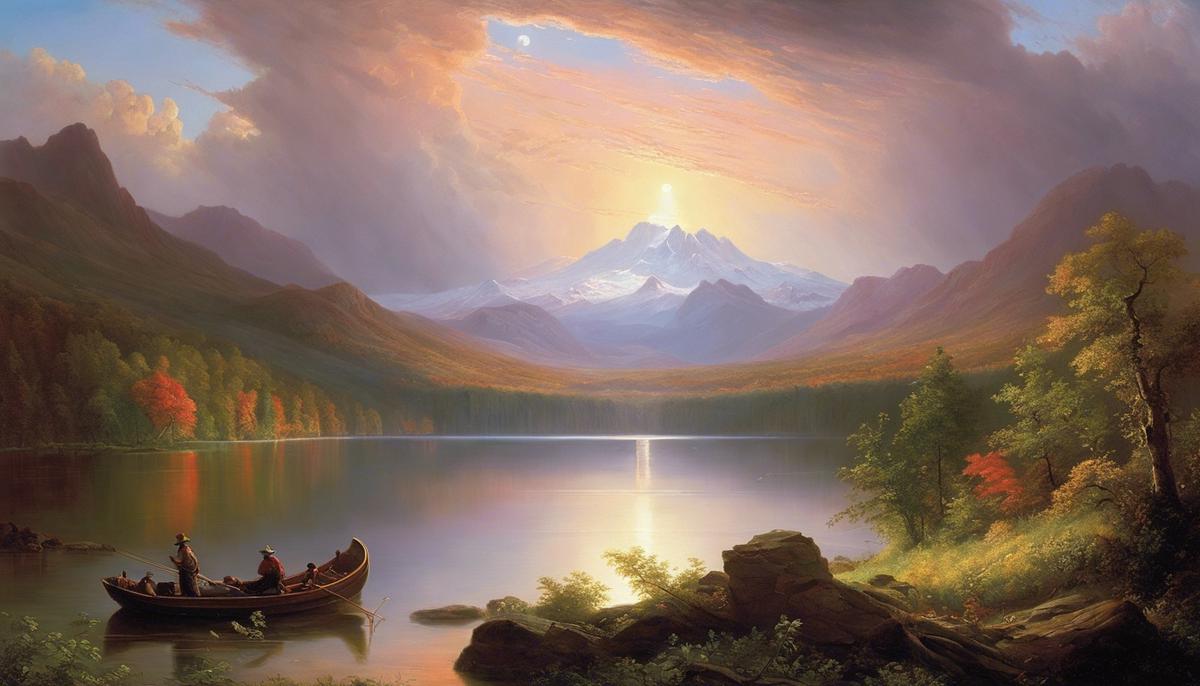
Influence of Scientific Discovery on Church’s Artwork
Amidst the ever-evolving landscapes created by Frederic Edwin Church stands the intricate intertwining of art and science. The scientific discoveries of the mid-nineteenth century significantly shifted Church’s artistic approach, steering his rendition of nature towards accuracy and precision.
The progress made during this period in fields such as geology and ecology, primarily through the works of Alexander Von Humboldt, spurred the curious spirit of Church. Humboldt’s piece ‘Cosmos: A Sketch of a Physical Description of the Universe’ particularly found a devoted reader in Church, who began to incorporate Humboldt’s lessons of observational detailing in his unique landscape compositions.
Humboldt’s theories on the interconnection of all entities in nature greatly resonated with Church’s principle of interconnectedness between the creator, creation, and the spectator. This kinship between art and science moreover amplified Church’s focus on the accurate depiction of geological elements and ecosystems. Detailed in his paintings of South America, Church’s focus on the morphology of mountains and the Amazon River’s ecosystem reveal a scientific precision, often attributed to Humboldt’s influence.
Astrophysics too found its way into Church’s canvases, notably in ‘The Star in the East’ and ‘Cotopaxi’, where the comet and volcanic eruptions are painted with meticulous attention to their scientific reality. The advances in space exploration during the era allowed for these celestial elements to be studied more extensively, which Church adapted into artistic form.
The advent of Darwinism and the Theory of Evolution also left their marks on Church’s masterpieces. Church’s paintings after the 1850’s showcase evolution—a direct reflection of natural selection theory. In ‘Heart of Andes’, the precision displayed in the variety of plant species echoes the then-current debates on evolution and biodiversity.
Interestingly, the shift towards encasing scientific truths in art invoked a new wave of realism in Church’s work. The three-dimensional accuracy and intricate geographical details of his masterpiece ‘The Iceberg’, for instance, make the painting both an artistic marvel and a scientific document of the era.
Intriguingly, the depictions of the effects of atmospheric refraction and diffusion of sunlight in Church’s artworks, such as ‘Rainy Season in Tropics’, hint towards the incorporation of scientific knowledge in his art. Meteorological findings, particularly those regarding light dispersion, became vital in creating the realistic atmospheric effects seen in Church’s works.
Therefore, Church cleverly utilised scientific discoveries of his era to enhance the accuracy of his landscapes. The blend of scientific knowledge and artistic intuition resulted in awe-inspiring, detailed works, rendering Church an extraordinary figure in the art world. This artistic journey into scientific landscapes ultimately became an exploratory voyage for Church, illuminating nature’s grandeur through his innovative blend of art and science.

Fusing the influences from his mentor, his travels, his spiritual beliefs, and his interest in the scientific discoveries of his time, Church established his own unique vision. The sweeping, detailed landscapes that dominate Church’s repertoire bear testament to his fascination with the natural world, translated onto canvas with meticulous precision and an unfailing eye for breathtaking grandeur. His interpretation of nature, however, went beyond mere visual rendition. In Church’s hands, nature transitioned from an object of beauty to a symbol of divine magnificence, its myriad forms and phenomena becoming visual metaphors for a grander, spiritual narrative. His work is thus an intricate fusion of the corporeal and the spiritual, the observed and the intuited, the worldly and the divine. Frederic Edwin Church, through his multitude of influences, emerged as more than an artist – he became a conduit for the splendour of the world around him and a storyteller of the divine narrative he perceived within it.
Recommend0 recommendationsPublished in Uncategorized





